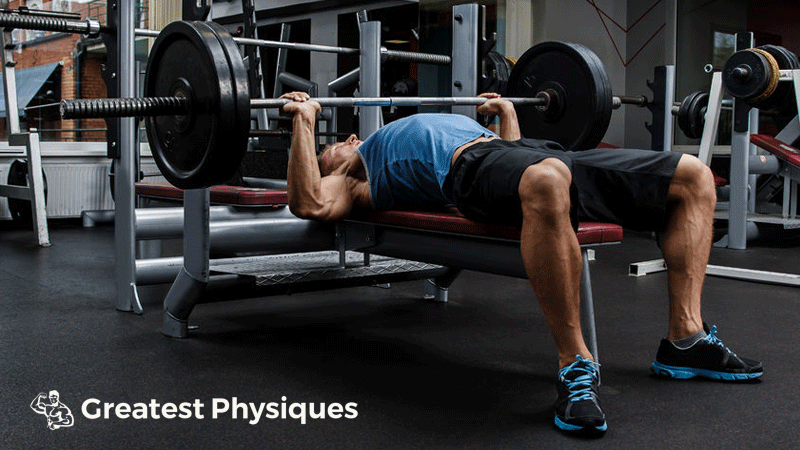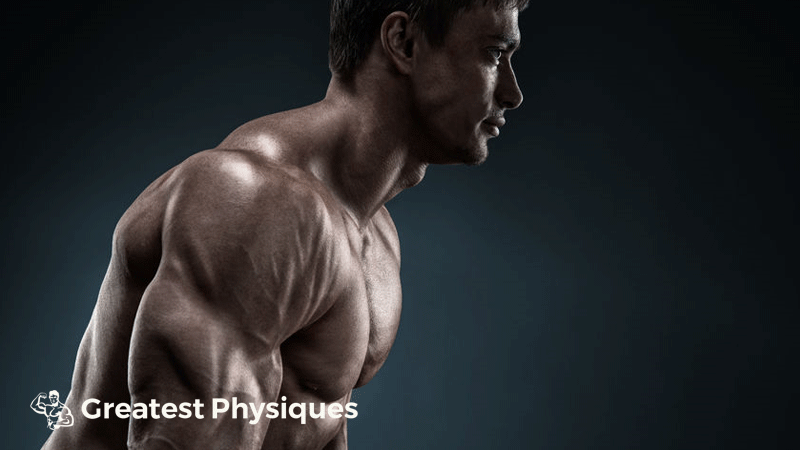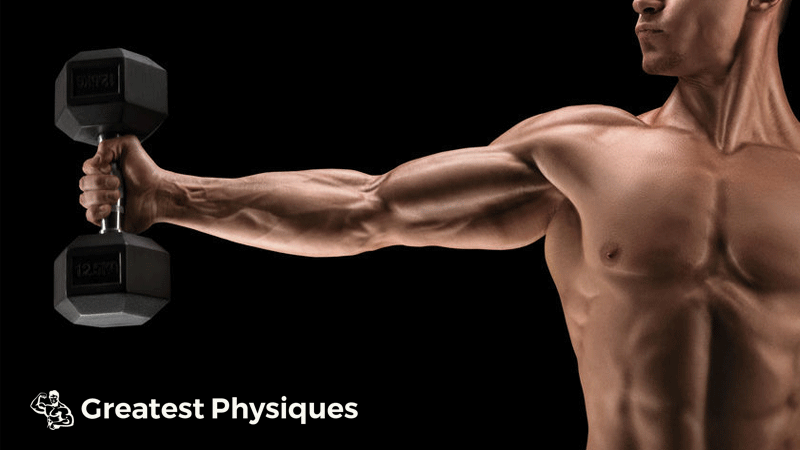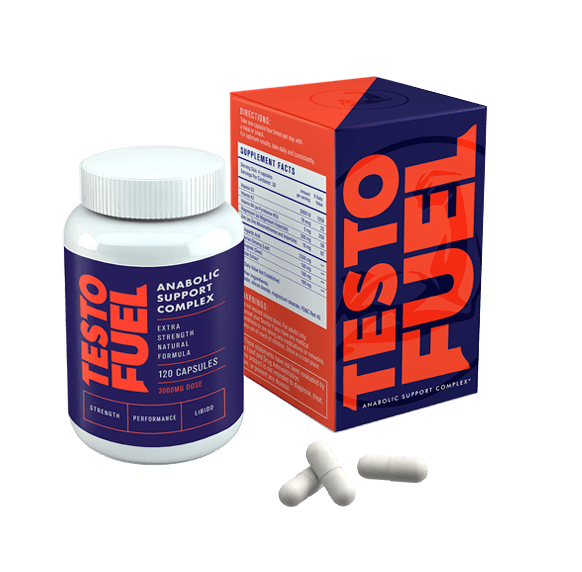
When it comes to building a barrel-like, bigger chest, it’s all down to choosing the right exercises.
Having an varied arsenal of strength training exercises for your pectoral muscles will help you achieve maximum growth.
And knowing exactly how to execute each one will help you achieve your goals quicker and more efficiently. It’s not just what you do, but how you do it.
In this article we take a look at the science behind training your pectorals and analyze what you need to know to build a bigger chest.
Let’s get going…
What Are the Pectorals?
What you refer to as your chest is actually a group of called the pectorals. It’s made up of the pectoralis major and pectoralis minor.
Often referred to as the torso muscles or simply ‘pecs’, these thick muscles connect your chest to your upper arm and are responsible for a number of movements.
Pectoral major
The larger of the two muscles is the pectoral major.
It originates at your collar bone and sternum as well as the cartilage of your upper ribs, and inserts high up into your upper arm, meaning it crosses your shoulder joint.
It’s fan shaped fibers and attachments sites allow four specific actions. These include:
- Adduction of the arm – such as during breaststroke swimming or putting your hand in your opposite side pants pocket.
- Retroversion when the arm is elevated – like when chopping wood.
- Flexion and and medial rotation of the arm – such as if you grabbed a doorknob with your right hand and turned it anti-clockwise.
Any exercise where you need to bring your arm forward and across your body will work this muscle group. As will pulling down towards the mid-line of your body from above your head.
Pectoral minor
Underneath its major counterpart is the pectoralis minor. As a small, flat and triangular muscle, this muscle plays sidekick to the pectoral major and lies deep down, concealed by it’s larger relative.
It originates at the outer surface of your upper ribs and its fibers run at an angle to its attachment at the corocoid process – a small hook of bone at the top of your shoulder blade.
It is involved in the following movement:
- Draws shoulder blades down and forward such as when you hug someone.
- Raises your ribs during a deep breath in.
Any movements that involve actions similar to pushing up from a chair, or taking a shot with a racket will involve this muscle.

Pectoral Science – How to Build a Bigger Chest
Optimizing progress through chest muscles anatomy is more than just lifting weights and hoping for the best.
By appreciating how this muscle works, its structure and specific biomechanics will have you wearing a more muscular, strong, bigger chest in no time.
Here’s what you need to know.
The pectorals are a large muscle
When it comes to cross-sectional area, your chest muscles are one of the largest in the upper body. With regards to actual volume, it’s the third largest (behind the deltoid and triceps) with an average total volume of 290 cm³ [1].
The pectoral major is essentially a two-headed muscle. It has one that attaches to your sternum and costal border and one that attaches to your colar bone.
These are important points when looking at maximizing the way you train it.
Your pectorals have a mixed fiber composition
Although the type and mix of muscle fibers you have will be commanded largely by genetics, research tells us that in most people, the mix between fast and slow twitch muscle fibers is pretty even.
It’s around 60% fast twitch [2].
There’s a huge amount of science behind muscle composition but all you need to know is this.
- Fast twitch fibers (type II) are large, strong and have a big potential to grow in size. They are predominantly targeted through heavy weights and low rep ranges.
- Slow twitch (type I) are smaller and produce less force. They can still grow in size. but not to the level of fast twitch fibers. You can target these with higher-volume, low intensity strength training.
Use a varied rep range for complete, bigger chest training
Because your pectorals have a fairly even distribution of fast and slow twitch muscle fibers, varying the loads you use and the rep ranges will help you achieve better overall growth.
Sticking to one rep range will target some, but not all of the different muscle fibers.
Switch your grip to hit every fiber
Because it has two different heads, the pectorals can be targeted at different angles.
It’s really down to chest muscles anatomy and knowing how to adapt to the exercise.
To hit the fibers that attach to your sternum you should use a wide grip that places your hands around 1.5 -2 times shoulder-width apart. Combine this with either a flat or decline bench to really target the muscle.
For the clavicular head that attaches to your collar bone, aim to go narrow with your grip and use a slight incline with your bench (no higher than 60 degrees or the emphasis shifts to your deltoids).

Chest Muscles Anatomy: Best Pectoral Exercises
To know whether or not an exercise targets the right muscles or not, scientists use a type of test called electromyography (EMG).
It’s considered to be one of the most effective and reliable methods of measuring muscle activity.
EMG involves placing electrodes over the muscle and then measuring how much it is activated during different exercises.
Here are the ones that you need to know about and how to perform them safely.
Barbell Bench Press
Pectorals, triceps, deltoids
Using a rack for safety, grab hold of the bar with a grip that’s 1.5 shoulder-width. Wrap your thumbs under the bar so that you have a full grip.
Unrack the bar and start with your shoulder blades pulled back slightly and the bar above your mid-chest. You can maintain a slight arch in your lower back throughout the lift.
Keep your elbows out as you lower the bar down to your chest. Keep control of the weight and stop when the bar is around an inch or so from your sternum.
Your forearms should be pretty much vertical at this point.
From there, drive the bar back to the start position and make sure you don’t completely lock out your elbows.
Incline and Decline Dumbbell Bench Press
Pectorals, triceps, deltoids
You can do this one with a pair of dumbbells or even a bar if you prefer. The main thing here is that you get the correct bench angle, which needs to be around -15 degrees for decline (only a small change from flat) and no more than 60 degrees for incline.
Grab a pair of dumbbells and adjust your grip so that your thumbs are facing each other and your palms are facing your feet.
Much like the barbell bench press, begin with your arms extended and in line with your mid-sternum. Your shoulder blades are pulled back slightly and you have a small arch in your lower back.
Keeping your elbows out, and a firm grip of the dumbbells, begin to bring the weights down to your chest, making sure that you move them in a wide arc. You’re aiming to bring your thumbs to the outside of your chest.
At the bottom position, pause briefly and then drive the weights up and inward so that they gently touch at the extended position. Make sure you don’t lock your elbows out to maintain tension on the target muscles.
Dumbbell Chest Flyes
Pectorals, deltoids
Start with a pair of dumbbells extended above your chest. Your grip should be in triangle shape, with your thumbs at the top. This means that only the top of the dumbbells will be touching.
Pull your shoulder blades together slightly and maintain a slight arch in your lower back. Your elbows are only slightly bent.
Initiate the movement by lowering the dumbbells, but while maintaining only a slight bend at the elbows – you’re aiming to go as wide as you can and focusing on really opening the chest out.
Your wrists and dumbbells are still maintaining the triangle position throughout.
Go as low towards the floor as your shoulder mobility will allow, but aim to get your wrists in line with your torso at the bottom position if you can.
Once at the bottom, drive the dumbbells up to the starting position, again making sure you maintain the slight bend in your elbows.
Dips
Pectorals, triceps, deltoids
You can do dips a few different ways, but to really target the pectorals you should use parallel bars at shoulder-width apart (or slightly wider).
Make sure you have a firm, full grip with your thumbs wrapped around the bars. Begin by taking your body weight while your arms are full extended.
To maximize involvement of the pectorals you should lean into the bars slightly so that your shoulders are in front of your hips. If it helps, bend your knees and lift your heels to counterbalance your weight.
Lower yourself down slowly and under control, making sure that you keep your elbows facing out and your torso leaning forward.
Go as low as feels comfortable, making sure your shoulders don’t roll forwards. If possible, you’re aiming to get your upper arms parallel with the floor.
Once at the bottom, drive upwards while keeping your torso fixed and stable. Don’t lock your elbows at the top of the movement, but make sure you do extend fully.
Cable Flyes
Pectorals, triceps
You can do this either standing or using a bench. You can also simulate flat, incline and decline positions quite easily – it’s a really versatile piece of equipment.
If you want to perform the standing variation, adjust the cable column accordingly.
- Mid-chest – adjust the cable to chest height.
- decline – adjust to shoulder height.
- Incline – bottom of your ribs.
Take hold of the handles and begin in the stretched position with your elbows slightly bent and your wrists just behind your torso.
Your shoulders should be just in front of your hips and your stance staggered to help with balance and stability.
Similar to dumbbell flyes, you’re aiming to arc the cables around as wide as possible while keeping a slight bend in your elbows. Aim to touch your thumbs together at the finish position.
Return to the start position under control. Keep your body stable throughout.
Push-ups
Pectorals, triceps, deltoids
As a real under-valued exercise, push-ups are all about how you set up.
Place your hands at 1.5 times shoulder-width apart, directly in line with your shoulders.
For the full push-up, rock your weight back onto the balls of your feet and make sure that your body is stable (you should have an imaginary line pass through your ear, shoulder, hip, knee and ankle).
With your elbows fully extended and your shoulder blades pulled together slightly, begin to lower your body to the floor. Maintain stability throughout and make sure your elbows flare outward.
Go as low as feels comfortable, but aim to get your upper arm parallel to the floor if you can.
Once at full range, drive upward, keeping the weight distributed through your pectorals.
Note: if you can’t quite manage the full position yet, you have two options. The first is to place your hands on a bench or box and perform a full position with hands elevated. Secondly, you can perform a half position where your knees are on the floor.
References
-
Ribeiro, AS et al. Large and small muscles in resistance training: Is it time for a better definition? Strength Cond J. 2017: 33-35
-
Srinivasan, R.C et al. Fiber type composition and maximum shortening velocity of muscles crossing the human shoulder. Clinical Anatomy. 2007; 20(2): 144-149




Comments are closed